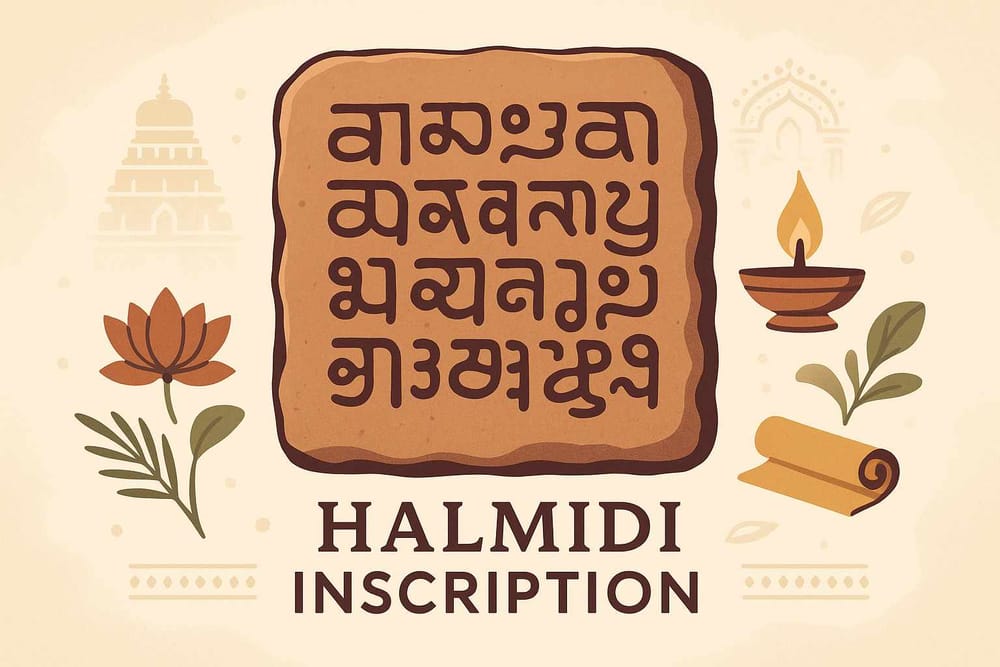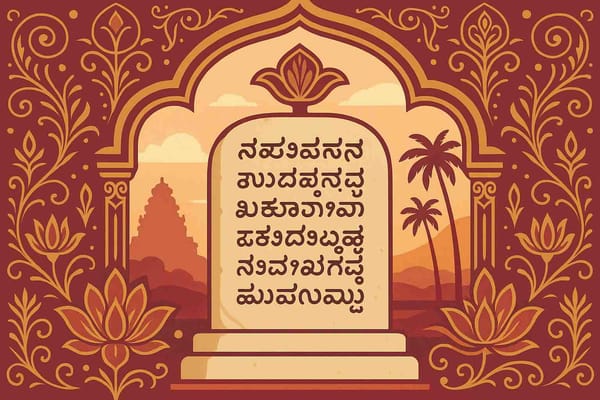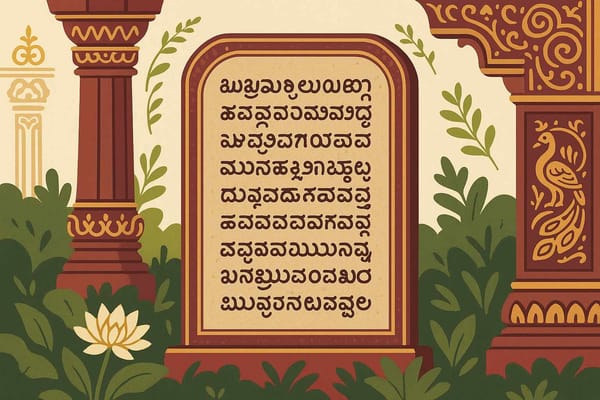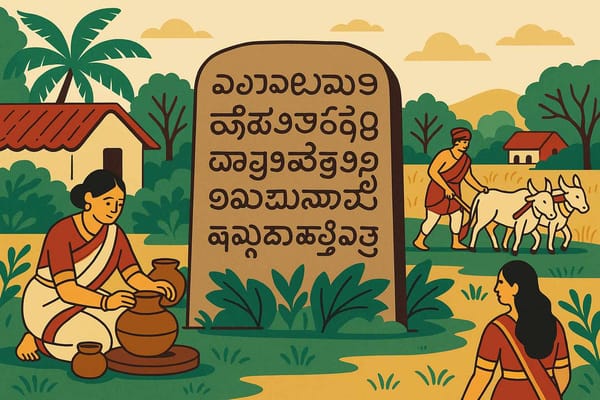
Understanding the Halmidi Inscription: Examines India's Oldest Kannada Script
Have you ever held an old letter from your grandparents? The faded ink, the delicate paper, it feels like you're holding a piece of their soul, a direct connection to your roots. Now, imagine finding a letter not from a grandparent, but from our ancestors who lived over 1500 years ago. That's exactly what the Halmidi Inscription feels like. It’s not just a stone slab; it's a voice from the past, whispering the earliest tales of our beloved Kannada language.
A Treasure Unearthed in a Quiet Village
Deep in the Hassan district of Karnataka, in a small village named Halmidi, this incredible piece of our history was waiting. Discovered in 1936 by the respected historian Dr. M. H. Krishna, this sandstone slab turned out to be something truly special. For decades, it was celebrated as the oldest known complete record written in the Kannada script. Imagine the excitement of realising that these carvings, dating back to around 450-500 CE, were the first full sentences of a language that now lives in the hearts of millions.
The script itself is a beautiful sight. It’s an early form, what scholars call ‘pre-old Kannada,’ and you can see the graceful influence of the ancient Brahmi script in its curves. Deciphering it was no easy task for historians; it was like learning a dialect spoken by our distant ancestors. But through their dedicated work, the message on the stone came to life.
What Does This Ancient Stone Actually Say?
The Halmidi inscription is not a grand philosophical text, but something far more personal and real. It is a record of everyday life and governance. It speaks of a grant, a gift of land, given to a warrior. It mentions names, places, and heroic deeds, painting a vivid picture of the society during the reign of the Kadamba dynasty.
This tells us something profound: Kannada was not just a language of the people, but also the language of the rulers. At a time when Sanskrit was often used for official matters, the Kadambas chose to honour their local language. This inscription is solid proof of their administrative sophistication and their deep cultural pride.
The Kadamba Kings: Guardians of Kannada's Identity
We cannot talk about the Halmidi inscription without honouring the Kadamba dynasty. They were one of the first true Kannadiga empires, and their contribution to our culture is immense. Their founder, King Mayurasharma, made a conscious decision to promote Kannada in his administration, a bold step that cemented the language's place in our history.
- A Shift Towards Regional Pride: The Kadambas understood that language is identity. By using Kannada for official inscriptions, they were telling the world that this land had its own voice, its own culture, and its own power. This nurturing of local language is a beautiful example of how royal traditions shape local celebrations and preserve heritage for generations to come.
- More Than Just Words: The Kadambas' support wasn't limited to language. They were great builders of temples and patrons of art, creating a cultural ecosystem where Kannada could flourish in every form, from stone inscriptions to literature and daily life.
Is it the Oldest? The Exciting Quest for Our Roots
For a long time, the Halmidi inscription held the undisputed title of the oldest. However, the story of our heritage is always unfolding, like a grand epic. In recent times, other, even older fragments of Kannada have been found. The stone inscription at Talagunda, for example, is believed to be from around 370 CE and contains Kannada words, making it a strong contender for the earliest usage.
But does this diminish the importance of the Halmidi inscription? Not at all. It remains the earliest known full-length inscription, a complete document that gives us a clear window into the past. This ongoing discovery only proves how deep and ancient our linguistic roots truly are. It’s a matter of immense pride that our history is so rich that we are still uncovering its secrets.
A Living Symbol of Our Heritage
Today, the original Halmidi inscription is carefully preserved in the Office of the Director of Archaeology and Museums in Mysore, with a replica installed in Halmidi village for all to see and feel connected to. For Kannada-speaking people, it is more than just an artifact in a museum. It is a symbol of Kannada Gourav (pride), a testament to the resilience and beauty of our mother tongue.
It reminds us that the language we speak today has travelled through centuries, carrying the stories, wisdom, and emotions of our ancestors. It’s a legacy that connects the past, present, and future in an unbroken chain.
Connecting with Our Roots Through Bhaktilipi
Just as the Halmidi inscription preserves a piece of our linguistic history, at Bhaktilipi, we are on a heartfelt mission to preserve our spiritual and cultural heritage. We believe that understanding treasures like this ancient Kannada record helps us connect more deeply with who we are.
We bring you timeless devotional stories and literature in a way that feels personal and inspiring for today’s world. By exploring our past, we enrich our present. To continue this journey of discovery and devotion with us, we warmly invite you to explore our platform, Bhaktilipi.in.
Stay connected with our community and receive regular doses of spiritual wisdom by following us on social media:
Cherishing a Legacy Carved in Stone
The Halmidi Inscription is a powerful reminder that our heritage is not just found in grand monuments, but also in the words we use every day. It stands as a tribute to the vision of our ancestors who cherished and elevated their mother tongue. By celebrating this remarkable piece of history, we honour the journey of the Kannada language and commit to preserving its richness for all the generations to come. It is, after all, a story carved in stone, but written in the heart of Karnataka.
A passionate group of people dedicated to preserving India's knowledge of Dharma, Karma, and Bhakti for ourselves and the world 🙏.
Comments
Related in

Halmidi Inscription: Decodes Past-Significance Reveals
Have you ever walked through an old temple or a historic site and wondered what stories the stones could tell if they could speak? In the heart of Karnataka, there is one such stone that does speak. It tells a tale from a time when a language, rich and full

Decoding the Halmidi Inscription- Ancient South India's Mysteries Explained
Imagine standing in a quiet village, the air filled with the scent of wet earth. Before you is a simple stone slab, but it's not just any stone. It’s a portal to the past. On its surface are letters carved over 1500 years ago, the very first

Halmidi Inscription Reveals Ancient Indian History
Imagine walking through a quiet little village, where life moves at its own gentle pace. You pass by an ordinary-looking stone slab, unaware that it holds a secret centuries old—a voice from the past waiting to be heard. This is the story of the Halmidi inscription, a discovery that
